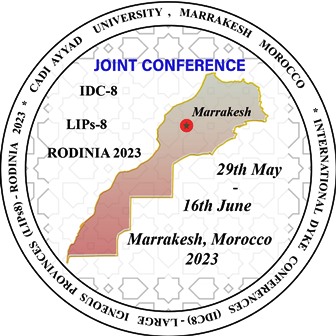

Joint Conference
International Dyke Conference (IDC 8)-Large Igneous Provinces (LIPs 8)-Rodinia 2023
JOIN US IN A GEOSCIENCE PARADISE : A VOYAGE THROUGH EARTH HISTORY IN THE KINGDOM OF MOROCCO
29th May-16th June 2023, Marrakesh, Morocco
|
|
|
TopicsCall for themes/topics Here are the proposed topics for the Joint Conference of Marrakesh Morocco 2023 (JC2M-2023): IDC8-LIPs8-Rodinia 2023: 1) Supercontinent Geodynamics, Plumes, LIPs, and Rifting Plume tectonics is in some ways as important as plate tectonics in the overall geodynamic history of the Earth. Plumes are interpreted as the source of many (majority?) of LIPs, and plumes plus LIPs are associated with triple junction rifting and the breakup (or attempted breakup) of continents to form new oceans. 2) Pre-Rodinia Reconstructions Some of the most important geodynamical implications of supercontinents require integrated histories of several transitions do they introvert, extrovert, orthovert, or alternate between end-members? Is there a quasi-regular super-continental cycle, and if so, far back in Earth history does it extend? The past decade has witnessed numerous forays into pre-Rodinian paleogeography, with many proposed reconstructions of Neoarchean-Paleoproterozoic super-craton assemblages, or even a full-fledged Kenorland supercontinent, rearranging into a Paleo-Mesoproterozoic Nuna (a.k.a. Columbia) amalgamation. Is the Nuna-Rodinia transition a large-scale reorganization of cratons culminating in assembly via a late Mesoproterozoic super-orogen, or a mere reshuffling coinciding with a "boring" billion years of environmental and evolutionary stability? 3) Rodinia to Pangea. The most recent full super-continental cycle culminated in a Pangea assemblage that was solved to first order over a century ago, yet the complete history "out of Rodinia" still contains geodynamic conundrums and paleogeographic parleys. Was there an intermediate Pannotia supercontinent, or do Ediacaran-Cambrian proxy records of super-continentality instead portray the Pan-African collisions leading to mega-continent Gondwana-Land as the first stage in a two-step process leading toward Pangea? What do the Neoproterozoic-Paleozoic LIPs tell us about geodynamics through a full cycle of super-continental transition 4) LIPs and their plumbing systems (including dykes) Flood basalts are fed by a plumbing system of dykes (giant radiating and circumferential), sills, and layered intrusions, potentially originating from a magmatic underplate, which can in turn be linked to an underlying mantle plume or perhaps a zone of delamination. 5) Supercontinents, LIPs, and Ore Deposits LIPs are associated with a range of ore deposits types, including magmatic sulfide deposits, hydrothermal deposits, laterite ores, and indirectly linked to some orogenic deposits (through the linking of ocean-opening, associated with LIPs, and corresponding transpression/compression on other plate boundaries) More broadly, plate tectonic processes have their own associated portfolio of ore deposit types. 6) Supercontinents, LIPs, and Climat Change LIPs are now recognized to be a main driver of rapid climatic changes including global warming, global cooling, anoxia events, acid rain and ocean acidification, and also mass extinction events. Supercontinent assembly and dispersal are also associated with transitions in climate (generally slower). Integrated study of Supercontinent history and LIPs (plus bolide impact and biological evolution) should be able to explain much of the climatic history of the Earth 7) Planetary LIPs There is an increasing role for applying the LIPs (and dyke swarm) paradigm to other terrestrial planets, notably on Venus and Mars. These planetary bodies and also the Moon and Mercury lack plate tectonics. These are one-plate planets and their magmatic histories are by definition intraplate. The larger intraplate events on these bodies have extensive dyke swarms and associated flood basalts that appear to be linked to mantle plumes/diapirs and are comparable in many ways to LIP events on Earth. 8) Dykes in collisional/subduction settings The focus in mafic dyke swarm studies over the past couple of decades has mostly been on intraplate events (including those of the LIP scale). However, it is time to pay attention to the dyke swarms (generally of smaller scale) that are part of the magma feeder system in collisional and subduction settings. A renewed focus on this class of dyke swarms will undoubtedly lead to new insights into the plumbing system of collisional / subduction magmatism. 9) Sedimentary and igneous phosphate Deposits: Formation and Exploration. Phosphate rocks are a vital resource for world food supply and security. They are the primary raw material for phosphoric acid and fertilizers used in agriculture and are increasingly considered to be a potential source of rare earth elements. Phosphate rocks occur either as sedimentary deposits or igneous ores associated with alkaline rocks. In both cases, the genesis of high-grade phosphate rocks results from complex concentration mechanisms involving several (bio)geochemical processes. Some of these ore-forming processes remain poorly understood and subject to scientific debate. 10) Alkaline Rocks and Carbonatites: Classification, Sources, Evolution, Emplacement, and Exploration. Alkaline-carbonatite complexes are abundant in the world and there are many unanswered questions about the formation of their associated ore deposits and on how to best to explore for them. Many carbonatites are linked both spatially and temporally with large igneous provinces (LIPs), which produce significant amounts of energy and metals that can either drive or contribute to a variety of metallogenic systems including Rare Metals (Li, Be, Ti, Zr, Nb, Ta, Th, and U), REE and other ore deposits. The main goals of this session are to expose the results of classification, sources, evolution, emplacement, and exploration of alkaline rocks and carbonatite and associated Ore Deposits. |

